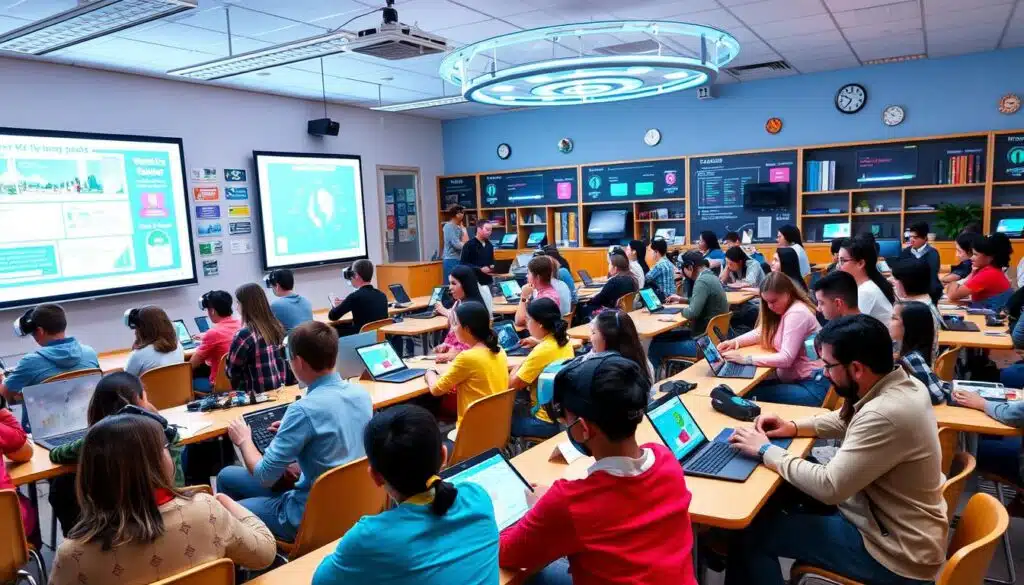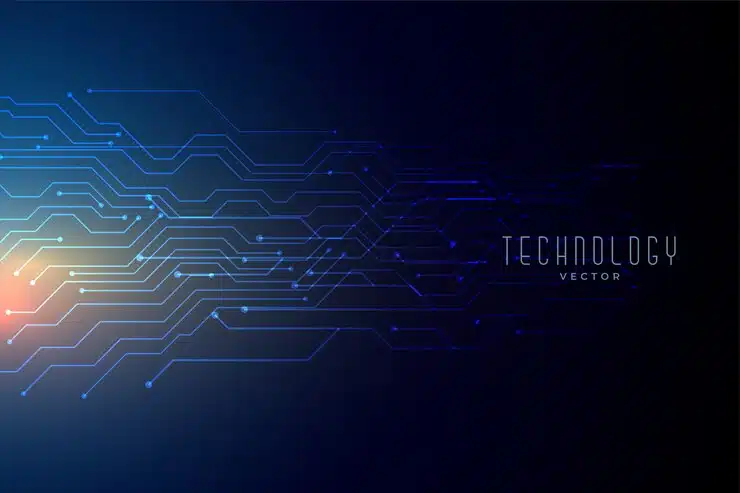The digital world has changed how we teach and learn. Now, information and communication technology (ICT) is key in education. It has changed education in big ways, making learning more engaging and innovative.
Digital tech has brought both good and bad changes to education. It can make learning more fun and tailored to each student. But, using these tools well needs understanding their power and building the right skills in schools.
The COVID-19 pandemic made us see how important digital skills are in schools. When classes went online, many schools struggled with technology. Now, leaders must work on making their schools more digital. This is key for fair education and getting students ready for the future.
Key Takeaways
- Digital technologies have changed education, making ICT a big part of teaching and learning.
- Using digital tech in schools well needs knowing what it can do and building the right skills and setup.
- The COVID-19 pandemic showed how important digital skills are in schools, revealing gaps and unfairness.
- Leaders must push for digital change to make schools better equipped for today and tomorrow.
- Adding digital tech to education can make learning more engaging, tailored, and effective.
Introduction to Digital Technology in Education
In today’s world, digital technology is key in schools. It includes many tools and platforms that change and improve learning. Things like interactive software, learning systems, smart classrooms, and digital books are making education better.
Also Read : What Are The Essential University Student Resources Every Freshman Should Know About?
Definition and Scope of Digital Technology
Digital technology uses digital devices to store, process, and send information digitally. It covers a wide range of tech, like blockchain technology, artificial intelligence, and machine learning. These tech changes how we use information and are now a big part of our lives, including school.
This tech lets us create new ways to learn that are more fun, tailored, and flexible. Digital technology in school includes tools like interactive software, apps, digital libraries, and analytics platforms. These tools help students stay engaged, improve learning, and offer personalized experiences.
| Digital Technology in Education | Description |
|---|---|
| Interactive Learning Software | Multimedia-rich educational software that engages students and enhances learning |
| Learning Management Systems (LMS) | Online platforms that facilitate the delivery, management, and tracking of educational content and activities |
| Smart Classrooms | Technologically-equipped learning spaces that integrate digital devices and tools to create immersive learning experiences |
| Educational Apps | Mobile applications designed to support and enhance various aspects of the learning process |
| Digital Textbooks | Electronic versions of traditional textbooks that offer multimedia features and interactive content |
As digital technology changes education, it’s important to know what it is and how it’s changing how we teach and learn.
Also Read : The Ultimate Guide To Beach Camping Adventures
Impact of Digital Technology on Education

Digital technology has changed education in big ways. It makes learning more engaging and improves how well students do. These changes have made modern classrooms more exciting.
One big change is how it makes students more involved in their learning. Tools like interactive software and smart classrooms make classes more fun and interactive. This keeps students interested and helps them take part more.
Learning management systems are another big plus. They help teachers manage lessons better and track how students are doing. This makes teaching and learning more efficient and effective.
Personalized and adaptive learning is another big step forward. These systems adjust to what each student needs, making learning more effective. Students can learn at their own speed, making education more engaging and successful.
Also Read : Seaside Picnic Ideas For A Memorable Beach Day
Digital textbooks and apps have changed how students get their lessons. They can learn anytime, anywhere, at their own pace. This makes learning more flexible and convenient.
“The integration of digital technology has revolutionized the way we approach teaching and learning, paving the way for a more engaging, personalized, and accessible educational experience.”
Types of Digital Technology in Education
Digital technology has changed education with many tools and platforms. Interactive learning software makes learning fun with apps, simulations, and games. Learning management systems help teachers keep track of lessons, tests, and talk with students.
Smart classrooms have digital boards and smart TVs for better learning together. Educational apps help with many subjects and work on different devices for learning by yourself. Digital textbooks are a new way to carry books without the weight.
Adaptive learning systems adjust to each student’s needs with data and algorithms. Digital libraries make learning easy by offering lots of resources online. Learning analytics use data to help make better decisions in education. Digital assessment tools make checking student work easier with technology.
Also Read : Beach Photography Tips To Capture Stunning Sunsets
| Types of Digital Technology | Description |
|---|---|
| Interactive Learning Software | Educational applications, simulations, and games that offer a dynamic and immersive learning experience. |
| Learning Management Systems | Tools that streamline the management of educational content and resources, enabling teachers to organize course materials, assessments, and communication with students. |
| Smart Classrooms | Classrooms equipped with interactive digital boards, smart TVs, or digital whiteboards, creating an engaging and collaborative learning environment. |
| Educational Apps | Apps covering a broad spectrum of educational topics, from language learning to math practice, accessible on various devices for personalized learning. |
| Digital Textbooks | Interactive and portable alternatives to traditional paper textbooks. |
| Adaptive Learning Systems | Systems that use data and algorithms to personalize the learning experience for each student, ensuring they receive the necessary support. |
| Digital Libraries | Digitized collections of educational resources, providing access to a wealth of information. |
| Learning Analytics | Technologies that collect and analyze data to inform data-driven decision-making in the educational process. |
| Digital Assessment Tools | Tools that enable teachers to efficiently evaluate student performance using digital methods. |
“The integration of digital technology in education has transformed the way we teach and learn, opening up new possibilities for personalized, interactive, and data-driven instruction.”
Benefits of Integrating Digital Technology in Education

Using digital technology in schools brings many benefits for students and teachers. It makes learning more engaging and tailored to today’s tech-savvy students. This approach creates a better learning space for everyone.
Increased Student Engagement and Interaction
Interactive software, smart classrooms, and apps make learning fun and dynamic. They keep students interested by offering interactive content and chances for feedback and teamwork. This leads to better memory and learning results.
Optimized Teaching and Learning Processes
Learning management systems help teachers manage classes better. They make it easy to share resources, teach, and keep track of student progress. Teachers can then focus more on helping each student directly.
Adaptive learning systems use data to tailor lessons to each student. They adjust the content and support based on how well students are doing. This way, every student gets the help they need to do well.
Digital textbooks and apps let students learn at their own pace. This flexibility makes learning more effective and leads to better grades.
Also Read : The Art Of Traveling Light Packing Smart For Any Trip
Personalized and Adaptive Learning
In today’s digital world, education has changed a lot. Digital tech has made learning more personalized and adaptive. Now, learning can be customized for each student’s needs and likes. This is thanks to data and algorithms in digital learning systems.
Adaptive learning systems lead this change. They check how well a student does, what they know, and how fast they learn. Then, they change the lessons to fit the student better. This way, students learn at their own speed and in a way that works for them.
Personalized learning is changing education a lot. With digital tech, teachers can focus on what each student needs and likes. This makes learning more fun and helps students do better in school.
| Key Benefits of Personalized and Adaptive Learning | Description |
|---|---|
| Individualized Instruction | Digital systems tailor content and delivery to the unique needs of each student, ensuring they receive the support and guidance they require to thrive. |
| Increased Engagement | By catering to students’ learning preferences and interests, personalized and adaptive learning experiences foster greater engagement and motivation. |
| Improved Learning Outcomes | The optimization of the learning process through personalization and adaptability leads to enhanced academic performance and mastery of subject matter. |
As digital tech gets better, so does personalized and adaptive learning in schools. By using data and algorithms, teachers can make learning more effective and fun. This helps students do their best.
“The future of education lies in the ability to tailor learning experiences to the individual, unlocking the full potential of each student.”
Challenges and Concerns
Using digital technology in schools has many benefits, but it also brings challenges. One big challenge is making sure teachers know how to use these tools well. They need to learn how to use digital tools in their teaching.
Not all schools or students have the same access to technology. This means some might not have the devices or internet they need. Creating good digital content is also hard. Teachers want to make sure online materials are interesting, informative, and show different views.
There are worries about students spending too much time on screens and if technology really helps learning.
Implementation and Effective Use
Adding digital tech to classrooms needs a good plan and support for teachers. Teachers should get the training and resources they need. This helps them use digital tools well and make learning fun and engaging.
Access and Support Resources
It’s important that all students can use digital technology. Schools need to have the right devices and internet for everyone. Teachers also need help and resources to use technology well in class.
| Challenge | Potential Impact | Possible Solutions |
|---|---|---|
| Effective Implementation and Use | Suboptimal integration of digital tools, decreased teacher and student engagement | Comprehensive teacher training, ongoing professional development, and access to support resources |
| Equity and Access | Widening digital divide, unequal learning opportunities for students | Investments in infrastructure, devices, and reliable connectivity, ensuring access for all students |
| Digital Content Development | Lack of engaging, informative, and diverse digital educational materials | Collaboration between educators, instructional designers, and content experts to create high-quality digital resources |
| Screen Time and Effectiveness | Concerns about the impact of excessive screen time and the efficacy of technology-enabled learning | Balanced integration of digital and non-digital learning activities, ongoing assessment and adjustment of teaching approaches |
We need to tackle these challenges and make sure teachers and students have what they need. This includes access, support, and training.
Digital Technology

Today’s education is changing fast, thanks to digital technology. It’s now a big part of how students learn and teachers teach. Tools like interactive software and learning systems are changing the game.
Digital technology in education is huge and always growing. It includes many digital tools and platforms. These help schools and teachers improve teaching and learning. You’ll find everything from smart classrooms and digital textbooks to AI-powered learning and augmented reality in education.
Adding digital tech to education is driving new ideas. It lets learning be more personal and flexible for each student. With better tech, there are more ways to use digital tools in class. This can make learning more fun, improve teaching, and change how we see education.
But, using digital tech in schools has its hurdles. Issues like access, fairness, and teacher skills need to be fixed. This ensures digital tech helps all students. By understanding tech’s role in education, schools can make learning better for everyone.
“The integration of digital technology in education has the potential to revolutionize the way we teach and learn, paving the way for a more personalized, engaging, and effective educational experience.”
Also Read : How Are Smart Cities Shaping The Future Of Construction Technology?
Conclusion
Digital technology is changing how we teach and learn. It brings many benefits and new ways to improve education. Students and teachers can now interact more and learn better thanks to digital tools.
These tools let students learn at their own speed and in ways that fit them best. This makes learning more effective and enjoyable for everyone.
But, using digital technology in schools isn’t without its challenges. Issues like fairness, making learning materials, and training teachers are some of them. Schools and teachers must work hard to overcome these hurdles.
By using digital technology wisely, we can open up new doors in education. This prepares our students for the jobs of tomorrow. The future of learning will be about using digital tools well to make learning exciting and relevant for today’s world.
FAQs
Q: What is the definition of digital technology?
A: The definition of digital technology refers to electronic tools, systems, devices, and resources that generate, store, or process data. This encompasses a wide range of technologies including computers, digital cameras, and mobile phones.
Q: How does digital transformation impact customer experience?
A: Digital transformation significantly enhances customer experience by enabling businesses to leverage big data and analytics for personalized services. It allows for real-time interactions and feedback, improving overall satisfaction.
Q: What are some examples of emerging technologies in digital transformation?
A: Examples of emerging technologies include artificial intelligence (AI), cloud computing, and automation tools. These technologies transform traditional business models and improve operational efficiency.
Q: How does big data play a role in digital communication?
A: Big data enhances digital communication by providing insights into customer behavior and preferences. This allows organizations to tailor their messaging and improve engagement through targeted campaigns.
Q: What are the challenges of digital transformation for enterprises?
A: The challenges of digital transformation for enterprises include managing change, ensuring technology adoption, and integrating new business models. Organizations must also address issues related to data security and digital ethics.
Q: Can you explain automation in the context of digital technology?
A: Automation in digital technology refers to the use of software and systems to perform tasks without human intervention. This can streamline business processes and increase efficiency by reducing manual effort.
Q: What is the ROI of investing in digital transformation efforts?
A: The ROI of investing in digital transformation efforts can manifest in various forms, such as increased operational efficiency, enhanced customer experience, and the ability to scale products and services more effectively. Organizations often see improved profitability as a result.
Q: How do cutting-edge technologies influence business processes?
A: Cutting-edge technologies influence business processes by automating routine tasks, improving accuracy through analytics, and facilitating better decision-making. This allows organizations to become more agile and responsive to market changes.
Q: What role does digital storytelling play in marketing strategies today?
A: Digital storytelling plays a crucial role in marketing strategies by creating emotional connections with audiences. It leverages digital media to convey brand narratives, enhancing engagement and trust with customers.
Q: What are the implications of digital ethics in technology adoption?
A: Digital ethics in technology adoption involves considerations around data privacy, security, and the moral implications of using digital tools. It is essential for organizations to establish ethical guidelines to ensure responsible use of technology.




